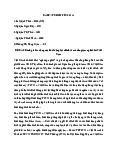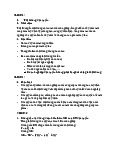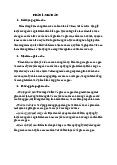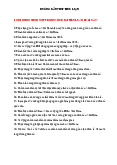






Preview text:
- Chapter 6 Monetary /163 T/F 1,2,3,4,7,,17,19,20,22 Multiple 1,3,4,5,14,16,22,23,
CHAPTER 6: MONEY AND BANKING
I. TRUE/ QUESTIONS (TRUE IS IN RED)
1.When the price of a product is stated in terms of dollars and cents, then money is
functioning as a unit of account T
2.Real estate would be an example of a highly liquid asset F
3.The money supply designated M1 is the sum of currency and savings (M2) deposits F
4.The currency component of M1 includes both coins and paper money T
7. The checkable deposits of the Federal government at the Federal Reserve Banks are a component of M1 F
17.The Federal Reserve Banks are owned and operated by the US Government F
19. The Federal Open Market Committee (FOMC) is the responsible for keeping stock market open and regulated. F
20.The Federal Reserve Banks are responsible for issuing currency T
22. The Federal Reserve acts as the fiscal agent for the Federal government T
MULTIPLE – CHOICE QUESTIONS: Circle the letter that correspons to the best answer
1.Which one is an economic function of money? a.A store of gold b.A unit of account c.A factor of production d.A medium of communications
3.Which one of the following items would be considered to be perfectly liquid from an economic perspective? a.Cash b.Stocks c.Real estate d.Certificate of deposits
4.Which one of the following is included in currency component of M1? a.Gold certificates b.Silver certificates c.Checkable deposits d.Federal Reserve notes
5.Checkable deposits are money because they are a.Legal tender b.Flat money c.Token money d.A medium of exchange
14.If the price level increase 20%, the purchasing power of money decreases? a.14.14% b.16.67% c.20% d.25%
16.To keep the purchasing power of money fairly stable, the Federal Reserve: a.Buys corporate stock b.Employs fiscal policy c.Controls the money supply d.Uses price and wage controls
22.The Federal Reserve is responsible for
a.Supervising all banks and thrifts
b.Printing currency for banks and thrifts
c.Collecting Federal taxes from banks and thrifts
d.Holding the required reserves of banks and thrifts
23.The most important function of the Federal Reserve is a.Issuing currency b.Controlling the money supply
c.Supervising banks and thrifts
d.Lending money to banks and thrifts
CHAPTER 6: MONEY CREATION
Multiple choices 4,7,14,15,16
4. A commercial bank has actual reserves of $9000 and liabilities of $30000 and the
required reserve ratio is 20%. The excess reserves of the bank are a. $30000 b. $6000 c.$7500 d.$9000
7.A depositor places $750 in cash in a commercial bank, and the reserve ratio is 33.33%,
the bank sends the $750 to the Federal Reserve Bank. As a result, the actual reserves and
the excess reserves of the bank have increased, respectively, by a.$750 and $250 b.$750 and $500 c.$750 and $750 d.$500 and $500
14.If the required reserve ratio were 12.5%, the value of the monetary multiplier would be a.5 b.6 c.7 d.8
15.The commercial banking system has excess reserves of $700, makes new loans of
$2100, and is just meeting its reserve requirements. The required reserve ratio is a.20% b.25% c.30% d.33.33%
16.The commercial banking system, because of a recent change in the required reserve
ratio from 20% to 30%, finds that it is $60 million short of reserves. If it is unable to
obtain any additional reserves it must decrease the money supply by a.$60 million b.$180 million c.$200 million d.$300 million
CHATER 6: INTEREST RATES, AND MONETARY POLICY
T/f 1,2,3,4,5,10,11,14,15,16,20,21
Multiple 2,3,4,5,6,7,8,16,18,20,21,22,23,24,25,26,27,28,29 True/False:
1.The goal of monetary policy is to lower interest rates F
2.There is a transactions demand for money because households and business firms use money as a store of value F
3.An increase in the price level would increase the transactions demand for money
4.An increase in the nominal GDP, other things remaining the same, will increase both
the total demand for money and the equilibrium rate of interest in the economy T
5.Bond prices and interest rates are inversely related
8.When the Federal Reserve sells securities in the open market, the price of these securities falls
10.An increase in the required reserve ratio will increase the lending capacity of banks F
11.If the reserve ratio is lowered, some required reserves are turned into excess reserves
14.The least effective and least used tool of monetary policy is the open-market
operations, in which government securities are bought and sold F
15.The Federal Reserve announces its changes in monetary policy by changing its targets for the Federal funds rate.
16.To increase the Federal funds rate, the Federal Reserve buys bonds in the open market
to increase the excess reserves of banks
20.In the cause – effect chain, an expansionary monetary policy increases the money
supply, decreases the interest rate, increases investment spending, and increases aggregate demand. T
21. A restrictive monetary policy is designed to correct a problem of high unemployment
and sluggish economic growth. F Multichoice:
2. If the dollars held for transactions purposes are, on average, spent five times a year for
final goods and services, then the quantity of money people will wish to hold for transactions is equal to a.Five times the nominal GDP b.20% of the nominal GDP
c.Five divided by the the nominal GDP
d.20% divided by the nominal GDP
3.There is an asset demand for money because money is a.A store of value b.A measure of value c.A medium of exchange
d.A standard of deferred payment
4.An increase in the rate of interest would increase
a.The opportunity cost of holding money
b.The transaction demand for money c.The asset demand for money d.The prices of bonds
Suppose the transactions demand for money is equal to 10% of the nominal GDP, the
supply of money is 450billion , and the asset demand for money is that shown in the table Interest rate Asset demand 14% $100 13 150 12 200 11 250
5. If the nominal GDP is $3000 billion, the equilibrium interest rate is a.14% b.13% c.12% d.11%
6.If the nominal GDP remains constant at $3000 billion an increase in the money supply
from $450 billion is $500 would cause the equilibrium interest rate to a.Rise to 14% b.Fail to 11% c.Fall to 12% d.Remain unchanged
7.The total quantity of money demanded is
a.Directly related to nominal GDP and the rate of interest
b.Directly related to nominal GDP and inversely related to the rate of interest
c.Inversely related to nominal GDP and directly related to the rate of interest
d.Inversely related to nominal GDP and the rate of interest
8. The stock of money is determined by the Federal Reserve System and does not change
when the interest rate changes, therefore the
a.Supply of money curve is downward sloping
b.Demand for money curve is downward sloping
c.Supply of money curve is upward sloping
d.Supply of money curve is vertical 16. Lowering the reserve ratio
a.Changes required reserves to excess reserves
b.Increases the amount of excess reserves banks must keep c.Increases the discount rate d. Decreases the discount rate
18.Which is the most important control used by the Federal Reserve to regulate the money supply? a.The reserve ratio b.Open-market operations c.The discount rate d.Term auction facility
21.When the Federal Reserve uses open-market operations to reduce the Federal funds
rate several times over a year, it is persuing
a.An expansionary monetary policy
b.A restrictive monetary policy c.A prime interest rate policy
d.A discretionary fiscal policy
22.The economy is experiencing high unemployment and a low rate of economic growth
and the Fed decides to persue an expansionary monetary policy. Which set of actions by
the Fed would be most consistent with this policy?
a.Buying government securities and raising the reserve ratio
b.Selling government securities and raising the discount rate
c.Buying government securities and lowering the reserve ratio
d.Selling government securities and lowering the discount rate.
23.The economy is experiencing inflation and the Fed decides to persue a restrictive
monetary policy. Which set of actions by the Fed would be most consistent with this policy?
a.Buying government securities and lowering the discount rate
b.Buying government securities and lowering the reserve ration
c.Selling government securities and raising the discount rate
d.Selling government securities and lowering the discount rate
24.In the chain of cause and effect between changes in the excess reserves of commercial
banks and the resulting changes in output and employment in the economy
a.An increase in excess reserves will decrease the money supply
b.A decrease in the money supply will increase the rate of interest
c.An increase in the rate of interest will increase aggregate demand
d.An increase in aggregate demand will decrease output and employment
25.Which is the most likely to be affected by the changes in the rate of interest? a.Tax rate b.Investment spending c.Government spending d.The imports of the economy AD4 AD3 AS AD2 AD1
26. A shift from AD1 to AD2 would be most consistent with
a.An increase in the reserve ratio by the Federal Reserve
b.An increase in the discount rate by the Federal Reserve
c.The buying of securities by the Federal Reserve
d.The selling of securities by the Federal Reserve
27.Assume that the Federal Reserve lowers interest rate to increase investment spending.
This monetary policy is most likely to shift a.AD3 to AD2 b.AD3 to AD4 c.AD4 to AD3 d.AD2 to AD1
28.A restrictive monetary policy would be the most consistent with
a.A decrease in the Federal funds rate and a decrease in the money supply
b.A decrease in the Federal funds rate and an increase in the money supply
c.An increase in the Federal funds rate and a decrease in the money supply
d.An increase in the Federal funds rate and an increase in the money supply
29.Assume that monetary policy increases interest rates and results in a decrease in
investment spending of $5 billion. If the marginal propensity to consume is 0.8, then
aggregate demand is most likely to a.Increase by $5 billion b.Decrease by $5 billion c.Increase by $25 billion d.Decrease by $25 billion




